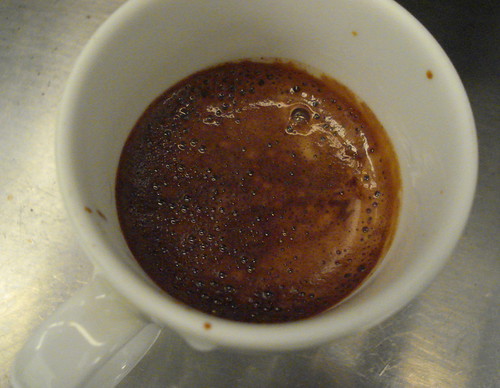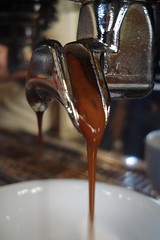It's hard to feel so divorced from coffee right now. To go from an incredibly social, high-energy job to one at which I am at a desk for roughly 9 hours a day is strange and disorienting, even if I am enjoying the new challenges it affords me. But I miss my regulars, I miss my colleagues, and I miss having an Americano any g.d. time I please (even if I don't miss, say, waking up at 6am).
But just because I've cut back behind the counter doesn't mean I've stopped thinking and theorizing, planning and plotting and scheming. It does, however, mean that I'm reduced to drinking crappy hours-old robusta sludge from the gas station quik mart across the street from my office, which is tragic.
Anyway, because I'll be spending some time over the next couple of weeks training near-novices how to pull professional-grade espresso shots, I've been thinking a lot about the value of visual troubleshooting guides, and of the ol' tiger stripe.
I know that there are nearly as many opinions of a "god shot" as there are baristas on this planet, and I know (because I'm occasionally told) that I, personally, prefer my shots on the short side, but I wonder if there is anything in particular one may tell a trainee to look for when pulling a shot, regardless of pers-pref (personal preference, that is).
(Going forward in this ramble, I'd like to say that I'm talking specifically within "specialty coffee," which implies a foundation of quality from the gate. I'm not comparing competition-level espresso with, say, the yellow water one gets at the end of a meal at 98% of this country's Italian restaurants.)
A while back, I stumbled upon this website, for instance: The Espresso Pages, From Sweet Maria's. (Sweet Maria's is a website dedicated to home roasting.)
This is a shot the folks at SM's have up as exemplary:
And this is one of my own:
They both look great to me, I would drink them both in a second! But I find it so fascinating how different, visually, a well-pulled espresso can be, shot to shot.
Of course, there are innumerable variables here (What kind of beans are they using, and what kind of machine, at what temperature? What is the weather like, how long did the shot sit, how warm was the demitasse?), but on the face of it, it proves a point.
To say an espresso is good is sort of like saying a girl on the street is pretty: Every good shot of espresso and every pretty girl may share this or that characteristic, but if you were to line them all up, one hopes one's taste is varied enough that they would all be rather different piece by piece. Right?
So how does one train one's pupils to pull good espresso? By making them taste, taste, taste and taste again. This is a people-driven industry, and a taste-bud driven industry.
And if there's no way of standardizing "great" espresso, the least we can do, I guess, is create great baristas.
One hopes.
6/16/07
Two days a week? No problemo.
Posted by
Meister
at
6:20 PM
![]()

